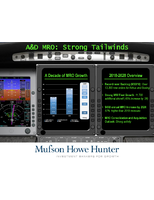NTSB makes recommendations for parachute jump operations.
Share:
Press Release Summary:
After study of parachute jump operations, NTSB issued recommendations to FAA and United States Parachute Association to address pattern of safety deficincies in several areas. NTSB noted inadequate aircraft maintenance and inspections, inadequate FAA oversight and direct surveillance, and lack of pilot initial and recurrent training programs and examiniation standards that address operation-specific and aircraft-specific considerations.
Original Press Release:
Safety Board Recommends Improved Aircraft Maintenance and Pilot Training for Parachute Jump Operations
The National Transportation Safety Board today released a special investigation report identifying several recurring safety issues with parachute jump operations, and
recommending improvements in aircraft maintenance and pilot training.
Parachute jump operations represent a segment of U.S. general aviation that transports about 3 million parachutists annually. Although the risks associated with parachuting are generally perceived to involve the acts of jumping from the aircraft, deploying the parachute, and landing, since 1980, 32 fatal accidents claimed the lives of 172 people in airplane accidents unassociated with these parachutist-controlled risks.
"As this activity increases in popularity, we have to ensure that safe operations are adhered to by all operators," said Acting Chairman Mark V. Rosenker. "Our recommendations in the areas of maintenance and training will move this industry forward in preventing these types of accidents."
The Special Investigation Report was prompted by the investigation of a July 29, 2006, de Havilland DHC-6-100 crash in Sullivan, Missouri. The aircraft, operated by
Skydive Quantum Leap as a parachute operations flight, crashed after takeoff from Sullivan Regional Airport. The pilot and five parachutists were killed and two other
parachutists were seriously injured. The Board determined today that the probable cause of the crash was the pilot's failure to maintain airspeed following loss of power in the right engine.
The Board's study of parachute jump operations issued recommendations to the Federal Aviation Administration (FAA) and the United States Parachute Association (USPA) to address a pattern of safety deficiencies in several areas:
o Inadequate aircraft maintenance and inspections
o Lack of pilot initial and recurrent training programs, and examination standards that address operation-specific and aircraft-specific considerations
o Inadequate FAA oversight and direct surveillance.
The Board concluded in the Sullivan investigation that more parachutists may have survived, and injuries may have been reduced, if more effective restraints had been used. "This clearly emphasizes the importance of implementing our recommendations designed to increase survivability when an accident does occur," said Rosenker.
As a result of the Sullivan investigation, the Safety Board made recommendations to the FAA and USPA regarding dual-point restraint systems for parachutists that reflect the various aircraft and seating configurations used in parachute operations.
A synopsis of the Board's reports, including the probable cause and recommendations, is available on the NTSB's website, www.ntsb.gov, under "Board Meetings." The Board's full report will be available on the website in several weeks.




